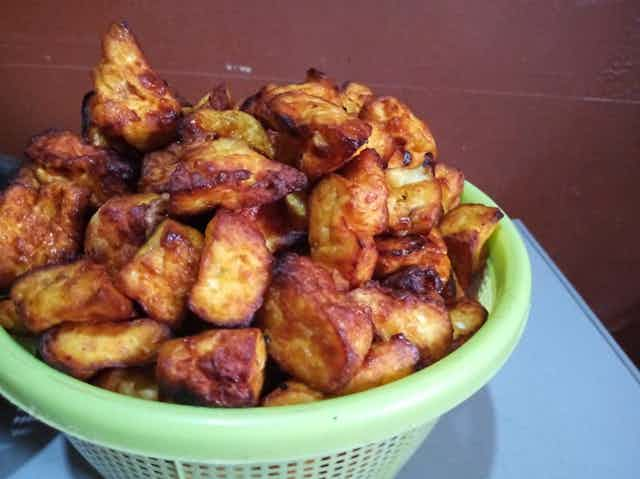Cheese is a highly nutritious food produced in hundreds of varieties around the world. It’s all made by fermenting milk but the results range widely in flavour, texture and end uses.
The global market value of cheese was about US$83.4 billion in 2022 and is projected to exceed US$120 billion in 2028.
In Nigeria, the most popular cheese is wara, a soft product with a mild, sweet taste and milky flavour. Wara is produced by coagulating cow’s milk with an extract of sodom apple (Calotropis procera, or bomubomu) and is traditionally sold in its whey (milk-like liquid), sometimes in a calabash, at room temperature.
Unhygienic conditions during production and sale, and lack of good packaging materials, can result in wara containing harmful microorganisms such as E. coli, Staphylococcus aureus and other bacteria. These can spoil the cheese or make a person ill after eating it.
Wara also has a very short shelf life of about two or three days. This can be prolonged by refrigerating, drying or frying the cheese but these processes usually affect the taste, texture, colour, flavour and other sensory properties. They also discard the whey, which is an essential component of wara.

As Nigerian food scientists, we set out to find a way to preserve wara more effectively in its indigenous form.
We used different amounts of sorbic acid and natural ginger as preservatives, separately and in combination, and compared the microbial load in the wara samples. We found that the best combination was 2.5% ginger with 0.05% sorbic acid, and that refrigeration was better than keeping the cheese at room temperature.
Extending its shelf life and improving its safety could boost demand and sales at all outlets, from informal to supermarkets. It would make a nutritious food more accessible and be good for producers and food processing businesses.
Our research
In our experiment we preserved wara with chemical and natural preservatives: sorbic acid and ginger respectively. We kept the wara in whey for three weeks.
Sorbic acid was added to different samples at a concentration of 0.05% and 0.1%, which is below its maximum permissible limit of 0.3% in cheese according to the international Codex Alimentarius standard. The ginger (known locally as atalẹ) was prepared by washing and peeling rhizomes, slicing them into thin sheets, drying them in an oven at 50°C, and cooling, milling and sieving the dried product to obtain ginger powder.

Wara was produced by filtering 2 litres of fresh cow’s milk. The milk was divided into four portions (A, B, C and D). Preservatives were added in the following concentrations:
5% ginger to portion A
2.5% ginger and 0.05% sorbic acid to portion B
0.1% sorbic acid to portion C
no preservatives in portion D.
Each mixture was boiled and an extract of sodom apple leaves was added while boiling. The curd (the solid which separates from the liquid whey) was moulded into a cone shape. Each curd was transferred into a sterile plastic container, covered in whey and stored in the refrigerator or at room temperature.
The populations and types of microorganisms associated with the preserved wara were determined every week. Microorganisms are important in fermenting milk and most are beneficial, but could cause spoilage if their growth is not controlled.
We also studied the effect of the preservatives on the sensory attributes such as taste, flavour, colour, appearance and texture of the wara samples.
The outcome
Preservation of wara with ginger and/or sorbic acid significantly reduced the population of microorganisms during storage. The use of 0.1% sorbic acid to preserve wara was the most effective in reducing bacterial and fungal count. The control sample without preservatives had the highest population of microorganisms. The addition of 2.5% ginger and 0.05% sorbic acid to wara reduced the microorganisms present and was much more effective than the addition of 5% ginger alone.
The physical examination of the stored wara showed that samples stored inside the refrigerator retained their fresh aroma throughout the period of storage. Those stored on the shelf at room temperature showed a change in aroma after two weeks. The samples without preservatives, stored at room temperature, had an offensive odour after a week. Spoilage of samples stored at room temperature was due to the higher rate of microbial metabolism.
There were no pathogenic (disease-causing) organisms in any of the wara samples throughout storage.
Wara samples stored inside the refrigerator had better quality in terms of microbial load, type of microorganisms, colour, texture and aroma than samples kept on the shelf at room temperature.
Freshly made wara samples without preservatives had the highest score for taste, flavour, colour, texture and overall acceptability. The values were not significantly different from the samples treated with 0.1% sorbic acid. Adding 2.5% ginger and 0.05% sorbic acid reduced the sensory scores of wara compared to the 0.1% sorbic acid sample.
In conclusion, we suggest that Nigerian wara can be produced on a large scale by using 0.1% sorbic acid or a combination of 2.5% ginger extract and 0.05% sorbic acid as a preservative. This will increase the time wara can be stored after production, thereby increasing the ability of the producers to scale up.
Preservation of wara can improve nutrition and create employment.

